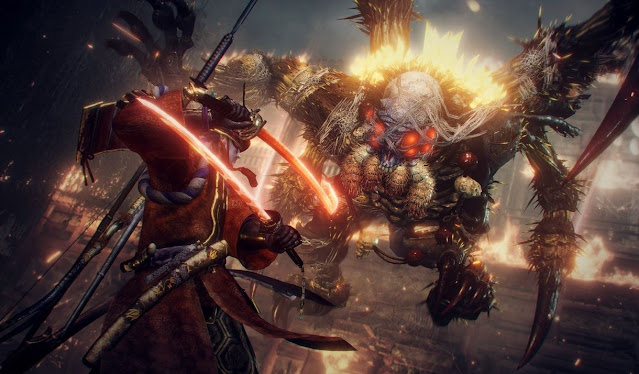One of the defining themes of the PlayStation 4 era was the remaster, with developers taking a PlayStation 3 (or even 2) title, massively overhauling the visual engine, and giving players a reason to play a favourite all over again. If the Nioh Collection is anything to go by, you shouldn’t expect a repeat this generation, because the upgrades aren’t anywhere near as transformative. Quality of life improvements aren’t something to sneeze at, but neither game “feels new” again. With that being said, both Nioh and its sequel are exceptional, and therefore this collection is essential.
This will be a shorter review, because I’ve already covered both Nioh and its sequel, and nothing about the game’s themes, narrative, aesthetics or design have changed. So just read those reviews: Nioh, and Nioh 2. However, if you have a 4K television, or a display that can handle 120 FPS, you do now have the option to play with those enhancements. They are, of course, visually impressive on a technical level at those settings, but Nioh’s real strength was in its art direction, and the team hasn’t gone away to redraw that hauntingly beautiful architecture and intricate monster design. Likewise, the only change to how the games play is some very light use of the resistive triggers and advanced rumble capabilities. In comparison to Demon’s Souls and the substantial effort to modernise it, it comes across as a little cheeky that Koei Tecmo only offered an upgrade option for Nioh 2.
But anyway. People can make the determination about whether the games are worth a repurchase by themselves. What I’ll do for the rest of this review is reflect on them both with the benefit of time from the first playthrough. Now that I’ve replayed them both, I have some firm thoughts about where the value lies in them. I believe Nioh is the superior game.
What distinguishes Nioh from all the other Soulslikes is that these games are rooted in real history. The names and places in Nioh and its sequel come from the Sengoku era – a period of civil war that has been the basis of much of Koei Tecmo’s work (see also: Samurai Warriors and Nobunaga’s Ambition). The oni and yokai monsters are, of course, a fiction, though they are drawn from Shinto mythology and real Japanese folklore. This gives the games a sense of heritage and cultural weight, as though you can learn something from playing it.
And, indeed, I did. I did not know anything about the original Nioh’s protagonist, William Adams, prior to playing. I vaguely knew about a “white samurai,” but that was about the extent of it. But then I played Nioh and, fictionalised take on the character as he is, I found “Samurai Bill” to be interesting enough to buy a book that told his story. And, then, I found the story so interesting that on a subsequent trip to Japan I went to his memorial park, located in Yokosuka, near Tokyo.
The way I understand it, one of the most common requests from players for Nioh 2 was to have a player-created avatar replace the named protagonist, and that’s what Koei Tecmo did. That being the case, it’s the best argument yet that developers should not listen to feedback when it conflicts with their own creative vision because, while Nioh 2 was set during the same time period, having that random drop-in to key scenes and events felt less nuanced and textured to the narrative than having a character that should be there. It’s still very, very good, and Koei demonstrated that it had really mastered the Soulslike structure and approach to design with this game. I also would be lying if I claimed that I didn’t enjoy my Hatsune Miku-looking character carving up a yokai storm. Nioh 2 arguably plays better than its predecessor, too, with a more complex and details combat system giving players more tactical options. But, nonetheless, the lack of a proper protagonist lessened Nioh 2, slightly, and ensured that where the original is something that will be remembered and analysed for years to come, the sequel won’t. It simply lacked the context that elevated it beyond “just a game.”
If you hadn’t played the Nioh games previously – perhaps concerned over their difficulty – then don’t let it miss you the second time. They are difficult, but that was essential in setting the desperate, nightmare tone and atmosphere. One other key takeaway that I’ve had from replaying both games for the remaster is this: what nearly made me quit the first time around has become comfortable now. The learning curve is glacially slow, but you do actually “learn” how to play these games, and there’s a real sense of reward that comes from pushing through. Now, if you have played these title already, the upgrade isn’t anything to write home about but, then again, perhaps you just want two brilliant games on your PlayStation 5. It’s not like either Nioh is going to age poorly; you’re going to want to revisit them at some point. You may as well play the best version.
– Matt S.









